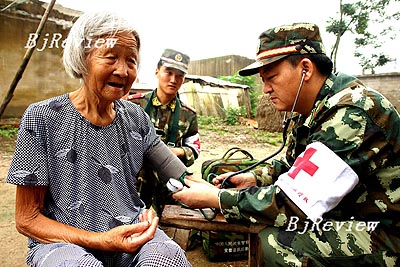
It has been an extraordinary summer for China with extreme weather that has tortured the country causing floods in the south and drought in the north.
Under these conditions diseases can spread quickly and thoughts of how to prevent an epidemic have been on the minds of everyone working in China's public health emergency response system.
"Public health is as indispensable to the country as the highways are, and to have a world-class public health emergency management system is a priority for the well-being of the people," said Huang Jianshi, a professor of epidemiology, and Assistant President of Peking Union Medical College.
China did once have an efficient public health system even though the country's economy was fragile. It was not until the early 1980s when market-oriented reforms swept across the land that the public health system began to become marginalized, and in some rural areas vanished altogether.
The 2003 severe acute respiratory syndrome (SARS) crisis caused panic across China and alarm spread to the international community, but the Chinese Government was able to control the crisis. "We came to an awareness that the reason the SARS epidemic was not controlled sooner was because of flaws and imperfections in the public health system," said then the Vice Health Minister, Gao Qiang.
This was a catalyst for the country to rebuild its broken public health emergency response system. According to the Ministry of Health, with a large injection of state finance, China is expected to have a command and decision-making system to deal with health crises ready for action at the end of 2007, five years after the SARS outbreak.
"China didn't pay real attention to having a public health crisis management system until the SARS epidemic. Though the motivation for building a system seems rather passive, the outcome is beneficial," said Wang Ke'an, a Chinese epidemiology expert.
Past glory
Civil war, epidemics, endemic diseases and lack of medicine had left the country in a miserable state in the 1930s and 1940s. After 1949 when the People's Republic of China was formally established, the government began to develop a system to care for the nation's health while fostering the economy. In June 1965, Mao Zedong called on the nation to shift its key health mission to the rural areas.
As a result, medical resources were balanced between urban and rural areas in China. Take the number of hospital beds for instance. In 1965, 40 percent of hospital bed places were in rural areas and ten years later in 1975 that percentage had climbed to 60 percent. At the same time, a large number of urban medical manpower was shifted to rural regions to help improve people's health in those areas.
At the end of 1968, a cooperative medical system was promoted across the country's rural areas. In 1980, a medical network including 510,000 regular doctors, 1.46 million part-time paramedical workers and 2.36 million medical assistants, covering disease prevention, medical services and healthcare for the vast rural population was in place.
Medical work back then was focused on basic medical services such as the prevention and stamping out of epidemic diseases. Although China was behind much of the world in economic terms its public health system was considered quite successful: it made use of low-cost medical services to guarantee a basic medical and heath shield for the enormous Chinese population.
In 1949 China ranked among the worlds lowest in terms of health. But by the end of the 1970s it had joined the list of countries whose citizens enjoyed all-round healthcare with 80-85 percent of the Chinese people covered by basic medical services, and average life expectancy had jumped to 70 from the 40 before 1949. Though China didn't rank high in the world GDP chart, its health record was something to be proud of.
The country's public healthcare system at that time was still at a primary stage but the "Chinese mode" won great recognition from the international community for its "lowest cost but largest health benefit" approach, and the country's achievements were even praised by the World Health Organization and the World Bank.
| 